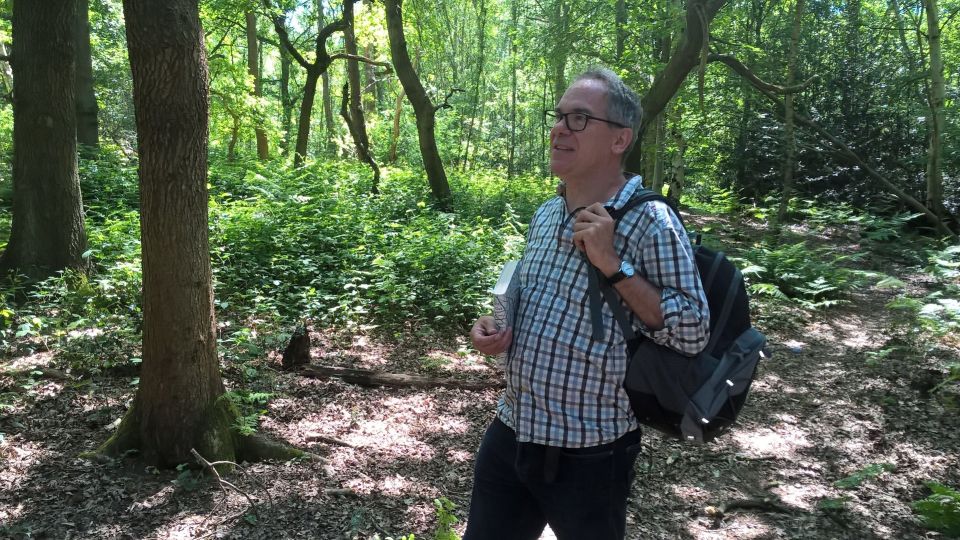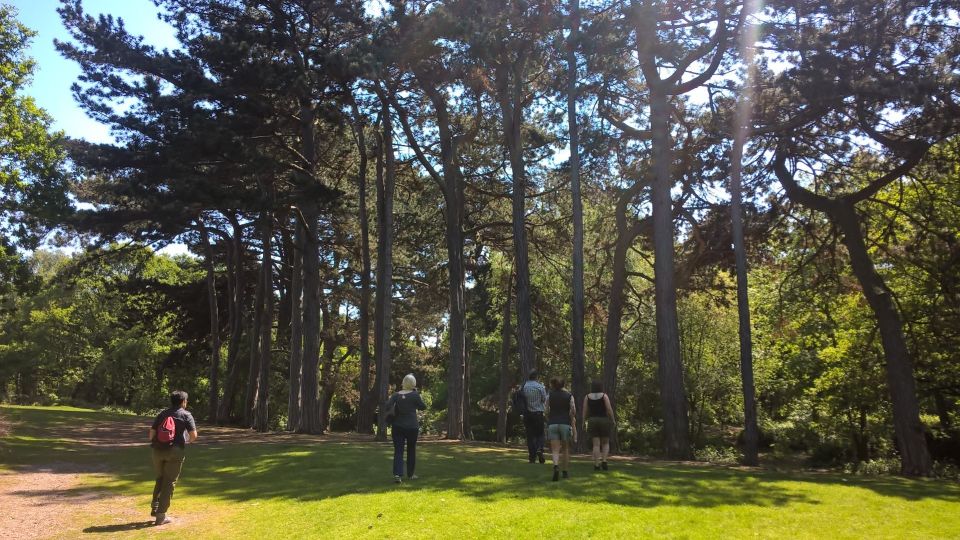A leafy world of magic and wonder: Interview with Peter Fiennes

Gurnam Bubber went to London’s first Urban tree festival and a tree walk with a difference where she had a chat with author and tree enthusiast Peter Fiennes.
GB: How did your journey with the trees start?
PF: I grew up in Sussex and then Kent, two of the most wooded counties in England. I was surrounded by trees and was very lucky to go on walks, exploring the woodlands. So my love of trees dates back to childhood. I moved to London when I was 20 and I’ve been living here ever since, but started feeling very disconnected from the woods and trees. In 2010 the government announced that they were going to sell off our public forests. I can remember there was a huge amount of outrage, a lot of protest, millions of people got involved and the government backed down. But once I’d gotten involved it made me curious about what was happening in the woods that I hadn’t been back to for so long.
How did you get involved with this festival?
I noticed that there was something called the Museum of Walking (MoW) and Street Trees with Paul Wood. I was following him on Twitter and noticed that he and the folk from MoW were talking about this Urban Tree Festival that they were planning. I thought it sounded exciting, so I got in touch to ask how I could get involved.


Tell me a bit about your book and how that came about?
I didn’t do it immediately. Getting involved with the campaign against the governmental sell off got me more interested in woods again. And I started following what Trees for Cities and the Woodland Trust were up to, which really piqued my interest. I did that for a while and then I met a publisher who wanted to commission a book about the need for woods and trees, that prompted me to go and investigate more deeply. I wanted to discover the extent to which they were under threat, and I had many questions. What do woods mean to us culturally? Why are they under threat? What’s happened to them? There were so many things to explore. I wanted to write a general book about the state of the trees if that’s not too grand. So I went and spent a year in the woods, finding out about them. I wanted to see what the real picture was and I learned that yes, they really were, and are under threat.
What do you think we can do at this time about the ever-present threat to woods?
It’s very easy to get disheartened because the news is often so bleak. But great things have been happening too. Recently the government announced the first timber conifer wood for the 1st time in 30 years.
They’ve also announced the great new Northern forest, which is going stretch from Hull to Liverpool. It’s going to take 25 years but they will plant around 50 million new trees. So there are good things happening, but the backdrop is gloomy. Britain has less woodland than any other European country, other than Ireland and the Netherlands so we’re really a long way behind. We have 12 per cent of tree cover now and France, Germany and Italy have around 35% of canopy cover. What we need to do, at least what I think we need to do is covered in the end of my book – the 35 point plan.
Everything that trees do is wonderful. We need woods for timber, woods for people to roam so they can enjoy themselves, and we need woods for beauty. It’s clear that we need to plant more trees but we need to break down this idea that we’re somehow separate from nature. The first thing we should do before we plant more woods is make sure we conserve what’s left because there’s so little ancient woodland remaining. We need to make sure no more of that is destroyed, and then we can plant more woods in both cities and the countryside. We need trees everywhere. It’s a big task, so it’s important to stay motivated.
You talk about not removing our old woodlands, how do you understand their value, what makes them more special?
We need to preserve our current ancient woodland because you can’t recreate old woodland by planting new trees, as they can take hundreds of years to have the same environmental impact as more established woodland. One way of thinking is that,“it’s ok to chop these down because we’ll plant more over there, in fact we’ll plant 10 times as many”, but it’s not the same. A single ancient tree like an oak supports 500 species and one oak sapling or a hundred oak saplings are not going to do that immediately. So the first thing we must do is make sure we don’t destroy any more ancient woodland. It’s extraordinary how little we have left, so we need to protect it.
You mentioned some wood folklore and myths on your walk just now. How did you find out about them?
I always loved the idea of magic in the woods. The idea that there’s an older deeper connection to things that we are missing because we‘re so busy leading our modern lives.
Peter Fiennes
Also through the romantic poets like Wordsworth, who wrote there is a spirit in the woods. He believed that and Coleridge of course wrote about it, so it dates back to the reading of poetry really.
When I knew I was doing this book I did two things, I read about the magic and folklore of woods. Obscure ones, people with amazing names, witches and warlocks writing about the magic of the woods. I steeped myself in them. There are some incredible thoughts and stories about woods. But I also tried to visit woods and open myself up to what I might experience. As I said in the reading from my book just now, if you go looking for that sort of thing, sometimes it’s hard to find it. Magic and other deeper feelings are those that surprise you when you’re not expecting them. They happen out of the corner of your eye, not in the full gaze.
What are your favourite woods?
That’s a difficult one. I liked the slightly spooky woods I visited called Wistman’s wood in Dartmoor. This is an old oak wood and until recently the oaks never grew above head height. They’re very high up on Dartmoor but they’re also in a gully and every time they poke their heads above the gully the icy winds would knock them back down again. There are sheep everywhere eating all the other oak trees. So they’ve survived but in the most extraordinarily contorted way. It’s a gothic wood, it’s really weird, it’s associated with Odin and Satan and all sorts of mysteries. They say that Arthur Conan Doyle set part of the hound of the Baskervilles there. It’s got a really spooky atmosphere, so I enjoyed it there.
I love many other woods too, so it’s a hard question to answer. Even Windsor Great Wood, if you go there it’s full of the most incredible old oak trees. We’re lucky that Britain has a very varied landscape. There are the most gorgeous old oak woods in the southern counties. Surrey is the most wooded county, it has the loveliest woods there, but also there’s the great Caledonian woods or what’s left of it in Scotland. The temperate oak rain forests in west Wales are well worth hunting down, because they’re so unique. The rain is sweeping off from the Atlantic or Irish sea all the time. They’re just drenched in lichen and they’re constantly wet but they’re beautiful oak forests at the same time. I could go on.
Do you have a fond memory of being in the woods as a child?
I have really fond memories of climbing trees, going for walks aged 5 to 7 in the woods and finding fallen sweet chestnuts trees. Big ones, or they seemed big at the time and clambering over those and then finding the leaves of the sweet chestnut and making them into fish bones by pulling them. I was really lucky to grow up near woods and have that opportunity. But everyone should have that opportunity and that’s what we should aim for, right?
I think it’s our only hope for the future, that we find ways to connect children with nature and with woods in the future. I know from my own experience that as a child you have to absorb it without realising that you are. You need to find ways to get children to be doing things in the woods in a way that counts, and inspires them.
Reintroducing children to trees should be part of the national curriculum, and we should give them the chance to explore the great outdoors more often. Forest schools are a most amazing innovation if people are lucky enough to go to them, but that seems unlikely for most people. 80 percent of us live in cities so we need to think of how to offer the same experience to children living in cities, either by planting more trees in cities or encouraging families to explore wilder terrain.
74%
of children spent less than 60 minutes playing outside each day
According to a new survey that questioned a nationally representative sample of 2,000 parents of 5-12 year olds. UN guidelines for prisoners require “at least one hour of suitable exercise in the open air daily”. Read more here.
It’s only when you get to know places that you learn to love them. You only need one visit and it can be subconscious can’t it, a life time of love can bloom from just one visit sometimes. Go to the ocean for the first time and it will stay with you forever. And it’s the same with woods, you just need to get children out there and get them doing normal things, climbing trees, enjoying being out there, and that’ll stick forever.
What message would you like folk to take with them?
Learn to live with trees again, remember how to live with them, remember to be with them, don’t forget them.
________________________
I’ll leave the final words to Peter’s book, Oak and Ash and Thorn. Talking about the ancient trees that we have left.
“But the survival of these few trees is thrilling. We have passed them through the generations with veneration and love and they are still here, our friendly giants, looming in the woods, cities, hedgerows, farms and parks. We should seek them out and give them the protection they need. No, more than that. We should be on our knees at their feet, begging forgiveness and enlightenment. They have a wisdom that we need.”
Read the first part of this article here: A day on Wimbledon Common with Peter Fiennes
Part 2/2
Donate to Trees for Cities and together we can help cities grow into greener, cleaner and healthier places for people to live and work worldwide.
Donate